By David Jones – founder, chairman and principal guide at Walk-ability, a Scottish charity planning and guiding hill-walks for the disabled and their carers.
This photo was taken on an ascent of Beinn an Dothaidh some years ago. It shows three of my friends: Hilary, Bob and Graham. Look at their eyes. Hilary is leading this little group, and is carefully assessing the path in front of her, deciding where to go next. Graham at the back has a huge smile on his face, and is clearly enjoying the day. But Bob, in the middle, seems more interested in looking at Hilary’s feet.
That's because Bob has tunnel vision: he sees the world as though through a camera lens. So he follows Hilary’s feet, deciding, step by step, where to put his own feet. Only when the group pauses can he afford to look up and take in the magnificent views.
Bob has Usher’s Syndrome, a degenerative condition that affects his hearing and vision. Right now, he is acutely deaf and his field of vision is about three degrees; this means that when he is talking to you, he will see your mouth for lip-reading and some of your face, but nothing else. Bob has always enjoyed hill-walking and he won’t let his deteriorating sight stop him from carrying on for as long as possible.
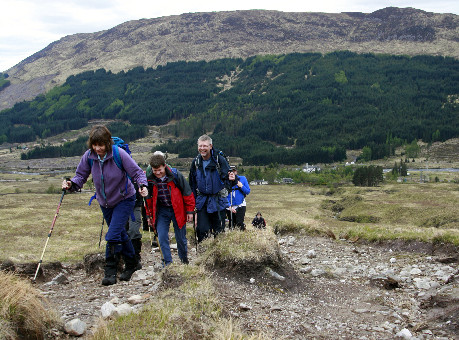
So what considerations are there when accompanying visually impaired people on a hill-walk?
It’s useful to consider how inexperienced hill-walkers with normal sight react to a challenging walk. They typically have three levels of comfort.
At level one, they have a good, well-defined path, clearly laid out in front of them and they have no difficulty walking along it. Everybody is happy at level one. At level two, the path becomes less well-defined. There are muddy stretches or burns to cross, and the route becomes indistinct as vegetation and rocks encroach. Inexperienced walkers may start getting a little nervous at this stage, because they can’t really see where they are going, and they miss the comfort of the well-trodden path. But it is at level three where they become particularly nervous. At this level, there may be boulders to scramble over, hands may be needed, and there may even be some mild exposure.
However, for walkers with limited visibility, the same three levels exist, but levels two and three are the other way around. At level one, all they need is a few words of advice (“Turn to your left a bit”, “Watch out for the overhanging branches”, “Careful, there’s a large rock on the path ahead” etc.) and they can manage perfectly well. The same is true at level three (“Move your left leg up a bit”, “Keep to the left of this boulder – there’s a good hand hold”, etc.) Partially-sighted walkers rarely suffer from exposure: they can’t fear what they can’t see, and all they need is a few words of advice and loads of encouragement.
But level two is tricky. Each and every step is a step into the unknown. They won’t know if a particular step will hit solid rock or soft mud; they won’t know if it will land at the same level as the previous step; they won’t know if the ground is level, or sloping up, down, left or right. In short, walking at level two can be treacherous for the partially-sighted.
A guide may not need to offer advice at every step, but he will certainly need to be monitoring every step. On occasions it may be prudent for him to offer a helpful arm for the client to hold on to. Guiding partially-sighted people at level two can be a challenge.
However, it is not difficult. It just requires patience and loads of time. As such, it can be very tiring, and progress will inevitably be much slower than normal.
Michael also has Usher’s Syndrome, but the condition is more advanced and he is now totally blind. Despite being well into his 70s, he keeps fit by running. In his earlier years he was a keen hill-walker, and sees no reason why he shouldn’t continue.
In this photo he is being guided by his daughter Fiona, carefully positioning herself just to the left of the easiest track. Essentially, they are going for a walk together, arm in arm, with Fiona ensuring that Michel doesn’t come a cropper by walking into something.
Although he can no longer see anything, he is keen to know about the surrounding landscape. Fiona will be telling him about the views; the mountains to their left, the tumbling burns, the lush farm land below them. All in all, this is no different to an ‘ordinary’ walk.
Fiona will also be keeping a close eye on the weather. She will be
advising Michael when to reach for his water-proofs, and checking that he has
applied sun cream effectively.
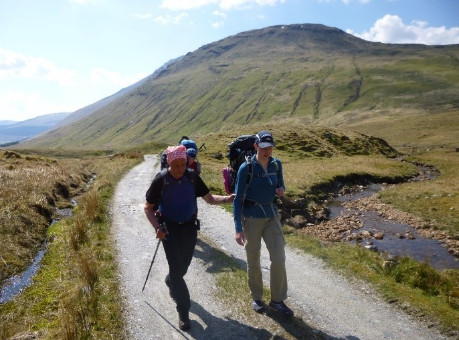
Michael with daughter Fiona.
But this route from Bridge of Orchy to Killin included a number of tricky river crossings.
Even wading through a shallow burn has its problems. A useful technique here is for two guides to use a walking pole as a support. Although Michael is still holding his daughter’s arm, he knows that if he were to slip the pole provides extra stability.
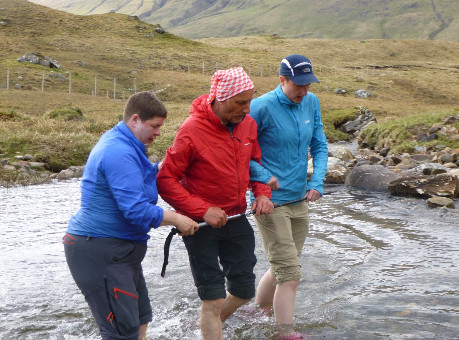
Using a walking pole as a support.
Some of the river crossings involved stepping stones.
The secret here is again to use walking poles, but this time more conventionally. Although he can see nothing, Michael can sense where the end of his walking pole is, so he can swing his foot forward to meet it. For each step, the guide positions the pole for him then tells him to move his foot into that position. It’s a painstaking and laborious process, but it reduces the risk of an unplanned dip.
Again, this is not difficult. It does, however, require three guides per client: one on either side providing stability and one at the front positioning the pole and providing the guidance. It is also very slow.
You will also notice that Michael had no rucksack at this point. We had taken it over the river for him. If he were to fall it would clearly be better for him to be as light as possible.
That evening we wild camped on the banks of Loch Lyon. Michael was clearly tired after a long day but insisted on putting up his own tent. When we tried to help we were firmly put in our place. All his kit was stowed away in his rucksack and he knew precisely where to find it. After we had guided him to an appropriate flat space he did the rest by himself.
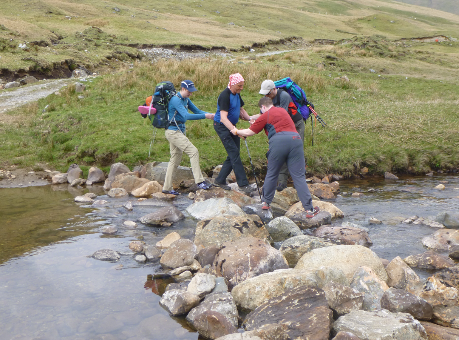
Additional guidance over stepping stones.
Mary is totally blind and was keen to climb Bennachie, a hill she knew well and had climbed many times before blindness set in and curtailed her walking.
Mary is used to being led by Vince, her trusty guide dog. The dog has been trained to walk slowly in front of her and to pause whenever a tricky step is required. Vince was, however, more used to busy high streets than to hill walks.
To help her on her ascent of Bennachie, we decided to use a human equivalent. A short sling attached to the first guide’s rucksack was the perfect solution, with two more guides behind helping out and offering words of encouragement. Mary felt comfortable and safe (but note how she still needed her white stick for added security).
Again, this wasn’t difficult, but time-consuming and needed three guides.
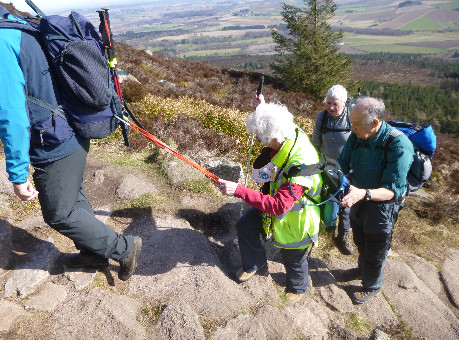
A sling used to provide support and reassurance.
Like Michael, Mary was keen to know what views she was missing. However, unlike Michael, she had developed very sensitive hearing over the years to compensate for her poor sight. At one point when we paused to gather our breath, she commented that she heard birds singing and trees creaking in the wind. We – her guides – had heard nothing, but she was quite right. We had stopped at a small copse, and the birds in the trees around us were indeed singing. She was also able to “feel” the slope of the ground, and had a good mental picture of where we had come from and where we were going.
The final few metres to the summit of Bennachie require a little scrambling (this is definitely comfort level three), and indeed many sighted hill-walkers decide to miss out on this last challenge. Mary, however, was determined to make it to the very top. The ascent was straight-forward enough, but slow and laborious. But, as all leaders will know, it is the descent that is trickier.
To do this, a first guide walked backwards in front of Mary guiding her every step, and a second guide followed behind with a sling to provide extra re-assurance. Another guide had taken her white stick and rucksack.
(It is worth pointing out that Vince, Mary’s guide dog, was having a marvellous time during this walk. Let off his guiding duties, he was bounding all over the hill taking advantage of the unexpected freedom like a puppy without a care in the world. But as we approached the car park Mary blew a whistle to summon him. He returned sedately to his tasks and carefully guided her safely back to the car.)
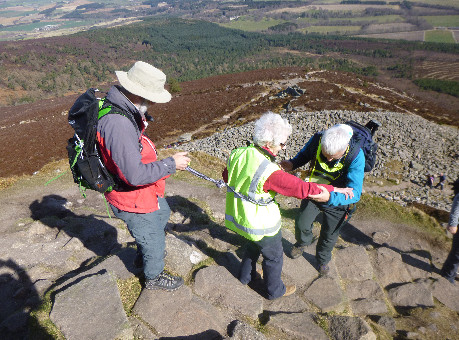
Guided from in front and secured from behind.
There’s no real difference between guiding a blind person and a ‘normal’ sighted person. It’s just a bit more laborious and time consuming.
For more information, go to walk-ability.co.uk.
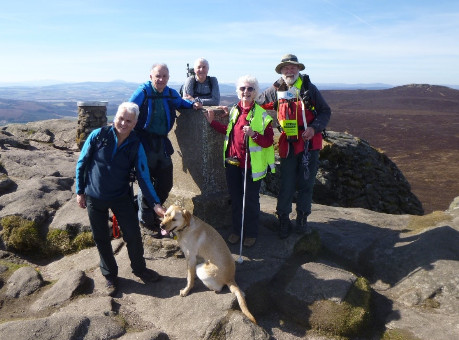
The summit photo.